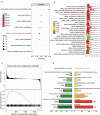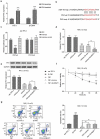Downregulation of NEAT1 reverses the radioactive iodine resistance of papillary thyroid carcinoma cell via miR-101-3p/FN1/PI3K-AKT signaling pathway
- PMID: 30596336
- PMCID: PMC6343742
- DOI: 10.1080/15384101.2018.1560203
Downregulation of NEAT1 reverses the radioactive iodine resistance of papillary thyroid carcinoma cell via miR-101-3p/FN1/PI3K-AKT signaling pathway
Retraction in
-
Statement of Retraction: Downregulation of NEAT1 reverses the radioactive iodine resistance of papillary thyroid carcinoma cell via miR-101-3p/FN1/PI3K-AKT signaling pathway.Cell Cycle. 2022 Dec;21(23):2550. doi: 10.1080/15384101.2022.2097797. Epub 2022 Jul 15. Cell Cycle. 2022. PMID: 35838519 Free PMC article. No abstract available.
Abstract
Considering the resistance of papillary thyroid cancer (PTC) 131I therapy, this study was designed to find a solution at molecular respect. By probing into lncRNA-NEAT1/miR-101-3p/FN1 axis and PI3K/AKT signaling pathway, this study provided a potential target for PTC therapy. 131I-resistant cell lines were established by continuous treatment with median-lethal 131I. Bioinformatic analysis was applied to filtrate possible lncRNA/miRNA/mRNA and related signaling pathway. Luciferase reporter assay was employed in the verification of the targeting relationship between lncRNA and miRNA as well as miRNA and mRNA. MTT assay and flow cytometry assay were performed to observe the impact of NEAT1/miR-101-3p/FN1 on cell viability and apoptosis in radioactivity iodine (RAI)-resistant PTC cell lines, respectively. Western blot and qRT-PCR were conducted to measure the expression of proteins and mRNAs in RAI-resistant PTC tissues and cells. Meanwhile, endogenous PTC mice model were constructed, in order to verify the relation between NEAT1 and RAI-resistance in vivo. NEAT1 was over-expressed in RAI-resistant PTC tissues and cell lines and could resist RAI by accelerating proliferation accompanied by suppressing apoptosis. It indicated that overexpressed NEAT1 restrained the damage of RAI to tumor in both macroscopic and microcosmic. Besides, NEAT1/miR-101-3p exhibited a negative correlation by directly targeting each other. The expression of FN1, an overexpressed downstream protein in RAI-resistance PTC tissues, could be tuned down by miR-101-3p, while the decrease could be restored by NEAT1. In conclusion, both in vitro and in vivo, NEAT1 suppression could inhibit 131I resistance of PTC by upregulating miR-101-3p/FN1 expression and inactivated PI3K/AKT signaling pathway both in vitro and in vivo.
Keywords: FN1; NEAT1; PI3K/AKT signaling pathway; PTC; RAI-resistance; miR-101-3p.
Figures











Similar articles
-
LncRNA CASC9 facilitates papillary thyroid cancer development and doxorubicin resistance via miR-28-3p/BCL-2 axis and PI3K/AKT signaling pathway.J Cardiothorac Surg. 2024 Nov 13;19(1):629. doi: 10.1186/s13019-024-03129-4. J Cardiothorac Surg. 2024. PMID: 39538340 Free PMC article.
-
Long noncoding RNA NEAT1 regulate papillary thyroid cancer progression by modulating miR-129-5p/KLK7 expression.J Cell Physiol. 2018 Oct;233(10):6638-6648. doi: 10.1002/jcp.26425. Epub 2018 May 10. J Cell Physiol. 2018. PMID: 29319165
-
MicroRNA-142-3P suppresses the progression of papillary thyroid carcinoma by targeting FN1 and inactivating FAK/ERK/PI3K signaling.Cell Signal. 2023 Sep;109:110792. doi: 10.1016/j.cellsig.2023.110792. Epub 2023 Jul 3. Cell Signal. 2023. PMID: 37406787
-
Significance of miRNAs on the thyroid cancer progression and resistance to treatment with special attention to the role of cross-talk between signaling pathways.Pathol Res Pract. 2023 Mar;243:154371. doi: 10.1016/j.prp.2023.154371. Epub 2023 Feb 11. Pathol Res Pract. 2023. PMID: 36791561 Review.
-
The emerging role and clinical significance of circRNAs in papillary thyroid cancer.Front Endocrinol (Lausanne). 2024 Mar 13;15:1351776. doi: 10.3389/fendo.2024.1351776. eCollection 2024. Front Endocrinol (Lausanne). 2024. PMID: 38544689 Free PMC article. Review.
Cited by
-
STAT3-induced up-regulation of lncRNA NEAT1 as a ceRNA facilitates abdominal aortic aneurysm formation by elevating TULP3.Biosci Rep. 2020 Jan 31;40(1):BSR20193299. doi: 10.1042/BSR20193299. Biosci Rep. 2020. PMID: 31868202 Free PMC article.
-
Integrated analysis of circulating and tissue proteomes reveals that fibronectin 1 is a potential biomarker in papillary thyroid cancer.BMC Cancer. 2023 May 8;23(1):412. doi: 10.1186/s12885-023-10839-w. BMC Cancer. 2023. PMID: 37158852 Free PMC article.
-
Roles of the SNHG7/microRNA‑9‑5p/DPP4 ceRNA network in the growth and 131I resistance of thyroid carcinoma cells through PI3K/Akt activation.Oncol Rep. 2021 Apr;45(4):3. doi: 10.3892/or.2021.7954. Epub 2021 Mar 2. Oncol Rep. 2021. PMID: 33649840 Free PMC article.
-
The Role of Long Non-coding RNA, Nuclear Enriched Abundant Transcript 1 (NEAT1) in Cancer and Other Pathologies.Biochem Genet. 2022 Jun;60(3):843-867. doi: 10.1007/s10528-021-10138-8. Epub 2021 Oct 24. Biochem Genet. 2022. PMID: 34689290 Review.
-
Transcription Factor E2F1 Exacerbates Papillary Thyroid Carcinoma Cell Growth and Invasion via Upregulation of LINC00152.Anal Cell Pathol (Amst). 2022 May 10;2022:7081611. doi: 10.1155/2022/7081611. eCollection 2022. Anal Cell Pathol (Amst). 2022. PMID: 35592867 Free PMC article.
References
-
- Zhang H, Cai Y, Zheng L, et al. Long noncoding RNA NEAT1 regulate papillary thyroid cancer progression by modulating miR-129-5p/KLK7 expression. J Cell Physiol. 2018;233:6638–6648. - PubMed
-
- Lupoli R, Cacciapuoti M, Tortora A, et al. Clinical outcome in differentiated thyroid carcinoma and microcarcinoma. Int J Surg. 2014;12(Suppl 1):S148–51. - PubMed
-
- Liu D, Hu S, Hou P, et al. Suppression of BRAF/MEK/MAP kinase pathway restores expression of iodide-metabolizing genes in thyroid cells expressing the V600E BRAF mutant. Clin Cancer Res. 2007;13:1341–1349. - PubMed
Publication types
MeSH terms
Substances
LinkOut - more resources
Full Text Sources
Other Literature Sources
Medical
Miscellaneous
